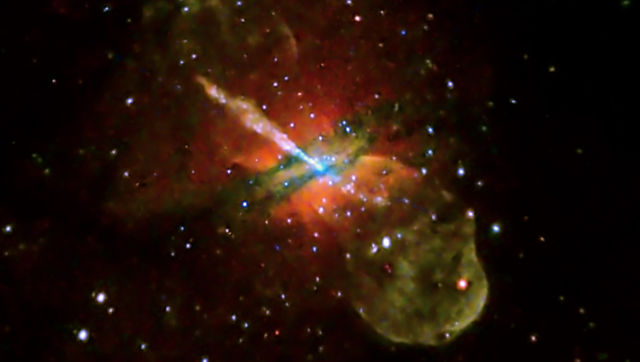
It seems that nearly every galaxy has a supermassive black hole at its core. Based on the presence of extremely bright objects early in the Universe's history, it seems that this relationship goes back to the galaxy's very start—galaxies seem to have been built around these monstrous black holes.
But this presents a bit of a problem. There's a limit to how fast black holes can grow, and they shouldn't have gotten to the supermassive stage anywhere near this quickly. There have been a few models to suggest how they might grow fast enough, but it's hard to get any data on what's going on that early in the Universe's history. Now, however, a team is announcing some of the first observational support for one model: the direct collapse of gas into a black hole without bothering to form a star first.
Most black holes form through the collapse of a star with dozens of times the Sun's mass. The resulting black holes end up being a few times more massive than our local star. But supermassive black holes are a different breed entirely, with masses ranging anywhere from 100,000 times to a billion times that of the Sun.
It's technically possible for a stellar mass black hole to grow to that size by drawing in surrounding matter, but the process takes time. Part of that is just getting that much mass into the vicinity of the black hole in the first place. But black holes are also messy eaters. As material spirals in, it heats up and emits radiation, which can push back against any further matter that's falling in. This process sets a limit—called the Eddington limit—on how fast material can enter the black hole.
To build a supermassive black hole quickly enough, a stellar mass black hole needs to be pushing up against the Eddington limit from almost the second it forms. Most researchers consider that unlikely, so they've come up with a variety of models (such as repeated black hole mergers) to explain how supermasssive black holes form quickly enough. But it's hard to spot any objects in the early Universe, much less understand what they are and the environment they're surrounded by. So there's been no good way to discriminate among these models.
But that may be changing. Over the past few years, researchers have been building a model of one possible explanation for supermassiveness: direct collapse. Rather than building a star, blowing it up, and then spiraling material into it, direct collapse black holes form when a massive cloud of gas collapses under its own weight. Since material doesn't spiral in, the gas can avoid the Eddington limit and fall in a straight line into the black hole, spurring rapid growth.
While this works on paper (or on supercomputer), there haven't been any examples of it happening identified in the real world. But the international team behind this model also calculated what something like this would look like. While the matter closest to the black hole would emit very high energy photons, all the surrounding gas would absorb most of these photons and gradually re-emit them at lower energies. By the time we'd see them, they'd be in the infrared area of the spectrum, with rapidly growing intensity in the redder area of the spectrum.
This model provided a signal that they could look for. So they checked for objects fitting that description in data from a multi-instrument observation campaign called CANDELS GOODS-S. To find the objects that were originally associated with a high-energy event, they checked whether the objects could be detected by the Chandra X-ray Observatory.
A couple of sources came through this screen, called Object 29323 and Object 14800. To generate the emission coming from Object 29323 simply by forming stars, the authors estimate they would have to be forming stars at a rate 5,000 times that of our Milky Way. That's twice the rate of the fastest star-forming object we've ever observed, a massive, mature, starburst galaxy. Since that sort of rate is, to put it mildly, unlikely, they argue that these objects are probably direct collapse black holes.
Finding out whether they're right might just take waiting a few years. The James Webb Space Telescope is getting ever closer to launch, and it's designed to image some of the earliest objects in the Universe.
The arXiv. Abstract number: 1603.08522 (About the arXiv). To be published in Monthly Notices of the Royal Astronomical Society.
reader comments
58